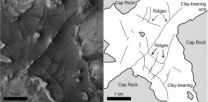(Press-News.org) PROVIDENCE, R.I. [Brown University] — A protein associated with neuron damage in people with Alzheimer's disease is surprisingly useful in promoting neuron growth in the lab, according to a new study by engineering researchers at Brown University. The findings, in press at the journal Biomaterials, suggest a better method of growing neurons outside the body that might then be implanted to treat people with neurodegenerative diseases.
The research compared the effects of two proteins that can be used as an artificial scaffold for growing neurons (nerve cells) from the central nervous system. The study found that central nervous system neurons from rats cultured in apolipoprotein E-4 (apoE4) grew better than neurons cultured in laminin, which had been considered the gold standard for growing mammalian neurons in the lab.
"Most scientists assumed that laminin was the best protein for growing CNS (central nervous system)," said Kwang-Min Kim, a biomedical engineering graduate student at Brown University and lead author of the study, "but we demonstrated that apoE4 has substantially better performance for mammalian CNS neurons."
Kim performed the research under the direction of Tayhas Palmore, professor of engineering and medical science and Kim's Ph.D. adviser. Also involved in the project was Janice Vicenty, an undergraduate from the University of Puerto Rico, who was working in the Palmore lab as a summer research fellow through the Leadership Alliance.
The results are surprising partly because of the association of apoE4 with Alzheimer's. Apolipoproteins are responsible for distributing and depositing cholesterols and other lipids in the brain. They come in three varieties: apoE2, apoE3 and apoE4. People with the gene that produces apoE4 are at higher risk for amyloid plaques and neurofibrillary tangles, the hallmarks of Alzheimer's. But exactly how the protein itself contributes to Alzheimer's is not known.
This study suggests that outside the body, where the protein can be separated from the cholesterols it normally carries, apoE4 is actually beneficial in promoting neuron growth.
Growing new neurons
In the body, neurons grow in what's called an extracellular matrix (ECM), a protein-rich scaffold that provides cells with nutrients and a molecular structure in which to grow. To grow neurons in the lab, scientists try to mimic the ECM present in the body. Laminin is a common protein in the body's ECM, and studies have shown that laminin aids the growth of neurons from the peripheral nervous system (nerve cells that grow outside the brain and spinal cord).
It was largely assumed, Kim said, that because laminin was good for growing peripheral nerve cells, it would also be good for growing central nerve cells. That turns out not to be the case.
Kim was inspired to test the effects of apoE4 by a previous study that found that a mixture of apoE4 and laminin promoted CNS cell growth better than laminin alone. "The previous work hadn't tested the effects apoE4 by itself," Kim said. "So we started working on a side-by-side comparison of apoE4 and laminin."
Kim and his colleagues cultured rat hippocampal cells — a model for mammalian CNS neurons — in four different treatments: laminin, laminin and apoE4 mixed, apoE4 alone, and bare glass. They found that cells cultured in apoE4 alone performed substantially better than any other treatment. The apoE4 cells were more likely to adhere to the protein scaffold, which is necessary for proper growth. They also showed more robust growth of axons and dendrites, the wire-like appendages that enable neurons to send and receive nerve signals.
Laminin doesn't seem to be of much benefit at all for culturing CNS cells, according to the study. Cells cultured on laminin alone did not perform any better than cells cultured on bare glass.
That was another big surprise, Kim said, because laminin is so widely used in all kinds of neuron cultures.
A second part of the research looked at the chemical pathways through which proteins may enhance neuron growth. Previous work had found two neuron receptors, the gateways through which neurons interact with the outside world, that play a role in how external proteins trigger cell growth. However, when Kim blocked these two receptors, known as integrin and HSPG, he found that apoE4 still enhanced neuron growth. That finding suggests that neurons use an as yet unknown pathway to interact with apoE4.
"This discovery opens up a new target for researchers who are interested in identifying receptors that are important for spurring neural growth," Palmore said.
Application to neural prosthetics
Unlike other cells in the body, nerve cells tend not to regenerate after being damaged by disease or trauma. So researchers hope that they can eventually implant lab-grown cells in the body to treat trauma or neurodegenerative diseases like Alzheimer's.
"People are looking at all these different proteins to see if we can make a material — a scaffold — that to a neuron, looks and feels like their natural environment," said Palmore. "The finding that apoE4 is a better protein to add to neural scaffolds is a good breakthrough because most people have been using laminin for the central nervous system models, which turns out to be less than optimal."
INFORMATION:
The research was supported by the National Science Foundation (HRD-0548311) and the National Institutes of Health.
Editors: Brown University has a fiber link television studio available for domestic and international live and taped interviews, and maintains an ISDN line for radio interviews. For more information, call 401-863-2476.
Researchers find a better way to culture central nervous cells
2013-01-29
ELSE PRESS RELEASES FROM THIS DATE:
BUSM study highlights attitudes toward HPV vaccination for boys
2013-01-29
(Boston)- A new Boston University School of Medicine (BUSM) study has found that low-income and minority parents/guardians were receptive toward vaccinating boys against Human Papilloma Virus (HPV). However, racial/ethnic differences emerged in attitudes regarding school-entry mandates. The findings appear online in the journal Clinical Pediatrics.
Although low-income and minority men have higher rates of oral HPV infection and are more likely to suffer from HPV-related diseases including penile, anal and oral cancers, few studies have examined parental attitudes after ...
Ants' behavior leads to research method for optimizing product development time, costs
2013-01-29
DETROIT – Trying to find just the right balance of time spent in meetings and time performing tasks is a tough problem for managers, but a Wayne State University researcher believes the behavior of ants may provide a useful lesson on how to do it.
Using computer simulations derived from the characteristics of ants seeking food, Kai Yang, Ph.D., professor of industrial and systems engineering in the College of Engineering, has developed a mathematical model-based methodology to estimate the optimal amount of time spent to develop a product, as well as the cost, in overlapped ...
Holocaust Edition: 'The Sources Speak'
2013-01-29
This press release is available in German.
A collection of historical documents from a major project funded by the Deutsche Forschungsgemeinschaft (DFG, German Research Foundation) will be made publicly available over the next several months and years. On 25 January 2013, German radio broadcaster Bayerischer Rundfunk will launch a 'documentary audio edition' entitled Die Quellen sprechen ('The Sources Speak'). The series of 16 episodes, to be broadcast on radio and made available online, will present hundreds of letters, diary entries, decrees, orders, newspaper reports ...
Personalized plans to address barriers to HIV drug adherence boost chances of successful therapy
2013-01-29
PHILADELPHIA – HIV patients who participated in an intervention that helped them identify barriers to taking their drugs properly and develop customized coping strategies took a significantly greater amount of their prescribed doses than those receiving standard care, according to a new study from researchers in the Perelman School of Medicine at the University of Pennsylvania. The results, published this week in JAMA Internal Medicine, may point to a new strategy to improve adherence to medications for many other conditions.
"Nonadherence to medical therapy is a silent ...
Cultural evolution changes bird song
2013-01-29
Thanks to cultural evolution, male Savannah sparrows are changing their tune, partly to attract "the ladies."
According to a study of more than 30 years of Savannah sparrows recordings, the birds are singing distinctly different songs today than their ancestors did 30 years ago – changes passed along generation to generation, according to a new study by University of Guelph researchers.
Integrative biology professors Ryan Norris and Amy Newman, in collaboration with researchers at Bowdoin College and Williams College in the U.S., analyzed the songs of male Savannah ...
'Moral realism' may lead to better moral behavior
2013-01-29
CHESTNUT HILL, Mass. — Getting people to think about morality as a matter of objective facts rather than subjective preferences may lead to improved moral behavior, Boston College researchers report in the Journal of Experimental Social Psychology.
In two experiments, one conducted in-person and the other online, participants were primed to consider a belief in either moral realism (the notion that morals are like facts) or moral antirealism (the belief that morals reflect people's preferences) during a solicitation for a charitable donation. In both experiments, those ...
New American Chemical Society podcast: Boosting the sensitivity of airport security screening
2013-01-29
The latest episode in the American Chemical Society's (ACS') award-winning Global Challenges/Chemistry Solutions podcast series reports a simple way to improve the sensitivity of the test often used to detect traces of explosives on the hands, carry-ons and other possessions of passengers at airport security screening stations.
Based on a report by Yehuda Zeiri, Ph.D., and colleagues in ACS' The Journal of Physical Chemistry C, the new podcast is available without charge at iTunes and from www.acs.org/globalchallenges.
In the new episode, Zeiri explains that most ...
NSF-funded team samples Antarctic lake beneath the ice sheet
2013-01-29
In a first-of-its-kind feat of science and engineering, a National Science Foundation (NSF)-funded research team has successfully drilled through 800 meters (2,600 feet) of Antarctic ice to reach a subglacial lake and retrieve water and sediment samples that have been isolated from direct contact with the atmosphere for many thousands of years.
Scientists and drillers with the interdisciplinary Whillans Ice Stream Subglacial Access Research Drilling project (WISSARD) announced Jan. 28 local time (U.S. stations in Antarctica keep New Zealand time) that they had used a ...
Fossilized conduits suggest water flowed beneath Martian Surface
2013-01-29
PROVIDENCE, R.I. [Brown University] — Networks of narrow ridges found in impact craters on Mars appear to be the fossilized remnants of underground cracks through which water once flowed, according to a new analysis by researchers from Brown University.
The study, in press in the journal Geophysical Research Letters, bolsters the idea that the subsurface environment on Mars once had an active hydrology and could be a good place to search for evidence of past life. The research was conducted by Lee Saper, a recent Brown graduate, with Jack Mustard, professor of geological ...
Researchers find gene that turns up effect of chemotherapy
2013-01-29
Chemotherapy is one of the most common treatments for cancer patients. However, many patients suffer from serious side-effects and a large proportion does not respond to the treatment. Researchers from the Biotech Research and Innovation Centre (BRIC) and Center for Healthy Aging, University of Copenhagen, now show that the gene FBH1 helps turn up the effect of chemotherapy.
"Our results show that the gene FBH1 is crucial in order for some chemotherapeutics to become active in the body and kill the cancer cells. If we can find a feasible method to increase the activity ...




